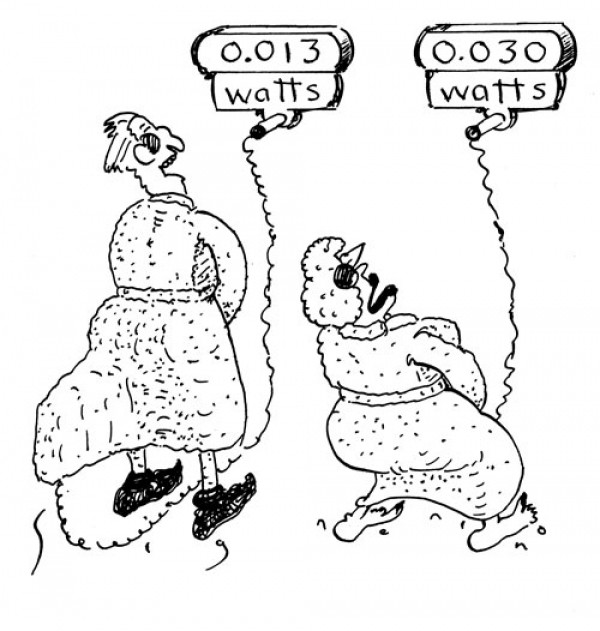How much power does a typical orgasm produce? Could a man or woman possibly power their Christmas lights for several seconds if they harnessed this energy somehow? —Larry
Christmas at your place must be a hoot, Larry. Nonetheless, I knew immediately that this was the type of investigation we at the Straight Dope were put on this earth to do. Making a preliminary reconnaissance of the journals, I came upon an article entitled “The Male Orgasm: Pelvic Contractions Measured by Anal Probe.” This lit a light bulb, so to speak. “Una,” I said to my assistant, “I’ve got a little project for you.”
Una wasn’t about to experiment on her own person. However, always ready to hit the books and run a spreadsheet or two, she established the following:
• Recent testing of straight couples suggests men burn about four calories per minute during sex and women about three. If we charitably assume the average sex act lasts 25 minutes, this equates to about 105 calories for men and 78 calories for women. When that energy is averaged over 25 minutes, the participants consume roughly a quarter of a watt each while having sex.
• A string of 100 incandescent Christmas lights draws about 40 watts, so on average a person engaged in sex uses enough juice to power a disappointing 5/8 of one light.
• Technology to the rescue. A string of 70 high-efficiency LED lights draws about five watts, meaning the average person having sex could power about 3.6 such lights, and a busy couple about seven. This still isn’t all that dazzling, but at least they’ll have enough illumination to find the remote and turn the TV back on.
• The above numbers refer to the sex act in toto—the energy that goes into an orgasm is much less. The contractions during climax can last from as little as five seconds for a man to well over a minute for a woman. Typical caloric expenditure during orgasm thus ranges from about one to two for men, and at most about four to seven for women. In other words, the total body energy used during orgasm is about 0.002 to 0.013 percent of a 550-calorie Big Mac.
“Una,” I said, “surely this understates matters. From observation we know the male orgasm exerts considerable propulsive force. Looking at that anal-probe article, I find a chart depicting the contractions of one subject’s orgasm. The pressure spike from baseline to peak is measured at about 225 centimeters of H2O. That’s more than seven feet. This guy is feeling his Cheerios.”
Una rolled her eyes, explaining that this figure had nothing to do with the subject’s actual projectile range; it simply told us the maximum anal tension measured during his orgasm was equivalent to the downward pressure exerted by a 225-centimeter column of water. Another letdown. She went on:
• Anal probes, while not without their drawbacks, were an improvement over the previous method of measuring orgasmic strength, namely coaxial needle electrodes, the mere thought of which makes one squirm.
• In the article in question (Bohlen et al, Archives of Sexual Behavior, 1980), 11 male subjects were fitted with probes and instructed to masturbate to orgasm. Interestingly, for most participants one of two types of orgasm was seen. In the first, the subjects had a regular series of contractions lasting 10 to 15 seconds, then they were done. In the second, the subjects had 10 to 15 regular contractions followed by additional contractions of diminishing strength at irregular intervals, the whole process taking up to 60 seconds. Subjects always had the same type of orgasm; they never switched around.
• In a 1982 study of female orgasms using similar techniques, Bohlen and company again found multiple types of orgasm, which for the most part corresponded to the male varieties. In the first type, the subjects had a dozen or so contractions over a like number of seconds, at which point game over. In the second, the subjects had a series of regular contractions followed by a longer series of irregular ones, for an average of 22 and in the extreme case 34. The pressure spike during each contraction was considerably less than for the men, possibly due to the fact that the women were physically smaller. But the type 2 female orgasms on average lasted 50 seconds and in one case 107 seconds—and no man alive can match that.
• Back to the question, Una continued. Using some seriously wild-ass assumptions about the pressure field produced in muscles, I calculate that a typical male orgasm puts out about 0.013 watts, while the female equivalent generates roughly 0.03 watts.
Controversy then erupted. I argued that, notwithstanding the occasional prolonged female orgasm, it was implausible that women on average generated twice the oomph of men. That’s because you’re a sexist pig, said Una. Be that as it may, the energy generated by either sex during orgasm is minuscule. So Larry, next time you fantasize about plugging yourself into the grid, remember: the Hoover Dam you ain’t.
Send questions to Cecil via straightdope.com or write him c/o Chicago Reader, 350 N. Orleans, Chicago 60654.
More by Cecil Adams
-
This Is the End, My Friend
This week's Straight Dope marks the last appearance of the column as the Teeming Millions have known it for the past 45 years.
- Jul 11, 2018
-
Do Brain Supplements Do Anything?
Brain Drain
- Jul 4, 2018
-
Is flying really worse for the environment than driving?
Planes and Trains
- Jun 27, 2018
- More »




